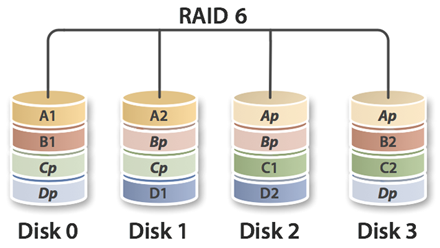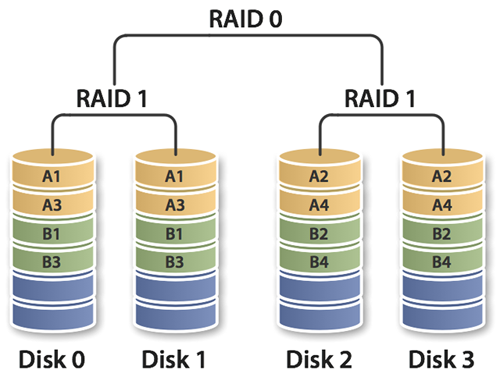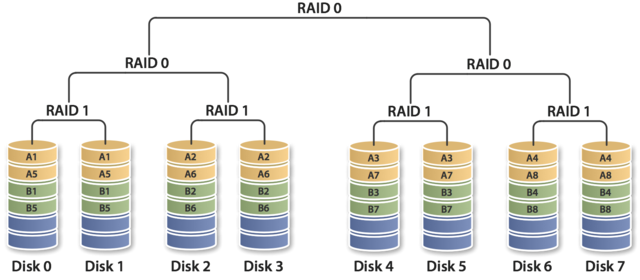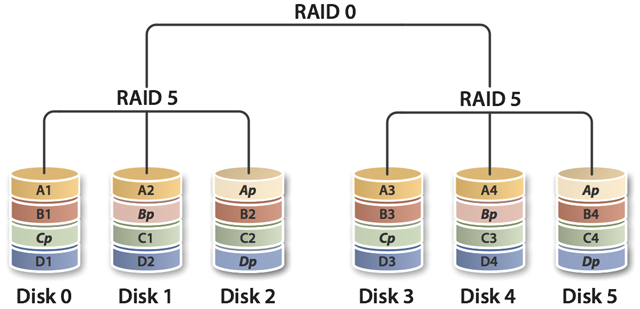RAID 6 requires a minimum of four drives to work, with what, that volume two is devoted to parity. The biggest advantage of RAID 6 is a resistance to the simultaneous failure even of two drives. In addition, the matrix is resistant tofailure of second disk at during when is the process of reconstruction of matrix after the failure of the first. This is much safer than RAID 5 and 5E/5EE. All the strips for both the parities is stored on all disks as it is in all levels with the number five in the name.

In general, RAID 6 has several different implementations, and a general definition of this level comes down to: "RAID, which reads and writes to all components of the logical drives can be continued despite the failure of any two disk simultaneously." Adaptec RAID controller which we were able to test the implemented RAID 6 in the form of block parity (XOR) and the block of coding correction Reed-Solomon. An approximate formula for the probability of failure of the sixth level of the matrix determines the formula: n (n-1) (n-2) R 3, where n is the number of disks, and r is the probability of failure of a single component disk of array. Similar to RAID 5, array sixth does not have loss of performance on reading, but decrease on recording due to the parity calculation. Well-implemented RAID 6 on a dedicated controller should keep the performance similar to RAID 5 built of one disk less. The solutions of firmware and software are rare, because the effort of computing the parity for the processor is just too big, and installation of specialized ASICs (Application Specific Integrated Circuit - stands for electronic integrated circuits designed to achieve pre-defined tasks) is expensive.
Data Retrieval among other things, specializes in raid 6 data recovery services & repair by certified raid 6 experts.
Basic and custom RAID levels are not the end of variety of the arrays. The next step are nested levels, often called hybrids. What they are? Simply say to: one type of RAID combining several copies of a different type of RAID. Generally it is a combination of RAID 0, which is to accelerate work, combined by it several copies of aredundant matrix such as RAID 1. This solution provides the smallest number of disks to rebuild in the event of failure of one drive in the array, hence the RAID 10 is preferred over RAID 01. Failure of one disk in the RAID 10 is associated with replacement and reconstruction of only the drive forming a part of one of the RAID 1. In a RAID 01 the same situation involves the replacement of one, but the reconstruction of data on whole RAID 0 array. Nested arrays are require more minimum number of disks (RAID 10 - four, RAID 1 - two) and you can easily create yourself for example, if we want to have RAID 10, and our main board or a dedicated controller does not support this level is sufficient to create two RAID 1, and then combine them into a RAID 0 by software such as Windows, or if the motherboard / controller hardware allow you to create a matrix with other matrices. Depending on the solution a such matrix can be not bootable.

General idea of naming the hybrid matrices is such that the lowest in the hierarchy of RAID level is the first digit, and each higher is each subsequent digit. Naming a matrices can also be roughly divided into two types: two / multi-digit numbers, or digits combined with a + or &. And so, two RAID 1 arrays linked via RAID 0 are marked as 1+0, 1&0, or most often 10. Worth However, it is know that most of the nested arrays is limited to two levels which are connected together (eg 01, 10, 50, 60). The exception here is RAID 100 (1 +0 +0) also known as 10 +0 and usually implemented as a software RAID 0 of two hardware RAID 10. This kind of RAID is similar to RAID 10 (made up of four RAID 1), but by spreading the work to a greater number of controllers, have better performance of random reads and better resistance to the risk of "hot spot".

Data Retrieval in San Francisco - data recovery raid
Nesting multilevel of matrix allow in practice, for create huge virtually unlimited matrices, creating a huge single logical drive. Hybrid arrays also providing often better performance than any single matrix, according to independent tests,RAID 10 loses in the capacity only with the RAID 0 (we will check it in our tests :-)). RAID 10 is indeed the most recommended for applications with intensive operations I / O such as databases, servers of pages or e-mail. Although on the field of available space, and reliability there is no such advantage. Available to the user the capacity of RAID 10, because, that most often used identical drives and, that the RAID 1 is almost always limited to two drives can be calculated from the formula: nc / 2, where n is the number of disks in the RAID 10, and c is capacity of the drives. RAID 10 is resistant to the failure of all drives, except one drive from every of matrix RAID 1 as component, so in a typical the four disks array, in two RAID 1, can be failure of one disk. In the case, when that such crash will be, probability of breakdown the entire of matrix RAID 10 is the same as single disk.

Data loss or failure in RAID system can occur due to various reasons. Whatever the reason behind data loss, Data Retrieval recovery lab in Phoenix,AZ will restore your data professionally




